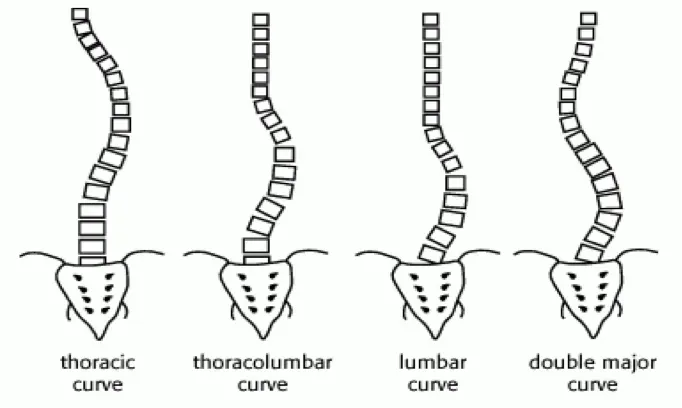Get Your lifestyle Back
Serving Texas, New Mexico, Arizona, Louisiana, Arkansas, Oklahoma, Colorado, Utah, and Missouri
What Is Scoliosis?
Scoliosis Defined
Scoliosis is the #1 spinal disorder afflicting school aged children and is one of the more common disorders of the spine in the population today. Scoliosis is said to be prevalent in about 4.5% or 13.5 million people in the United States.
Scoliosis is defined as an abnormal lateral or side to side, three-dimensional deformity of the normal straight spine measuring 10 degrees or more, using the Cobb angle method of measurement. The spinal column creates a side to side “S” shaped curvature and vertebral rotation occurs causing the “rib hump” often viewed from behind.
Scoliosis is one of the oldest existing deformities. Hippocrates invented a treatment for scoliosis between 460-377 BC. He wrote, “There are many varieties of curvature of the spine even in persons who are in good health; for it takes place from natural conformation and from habit.” Galen first used the term scoliosis in the second century. Derived from the Greek word Skol, which means “twists and curves” (Lakshmanan, Peehal, and Ahuja 2008). However its cause and mechanism for progression are still not completely understood.
Types of Scoliosis
Idiopathic Scoliosis
There are several types of scoliosis. Idiopathic scoliosis is the most common seen today and is about 80% of all diagnosed cases. Idiopathic Scoliosis means literally “of unknown cause”, where no underlying condition or cause of the spinal deformity has been found.
4 Types of Idiopathic Scoliosis
Infantile Idiopathic Scoliosis (From birth to 3 years of age)
Juvenile Idiopathic Scoliosis (From 3 to 10 years of age)
Adolescent Idiopathic Scoliosis (From 10 to 18 years of age)
Adult Idiopathic Scoliosis (From 18 years and older)
Congenital Scoliosis
Congenital Scoliosis is another type of scoliosis that involves structural cause. The spinal bones do not form properly during fetal development and a hemivertebra (a triangular shaped) bone is formed. Normally the vertebra of the spine align one on top of the other, when a hemivertebra is present it causes a sharp angle to occur and the body’s natural reaction is to develop the scoliosis keeping the head aligned with the pelvis. Other congenital causes could be an anatomical short leg or sacrum structural problem.
Neuromuscular Scoliosis
Neuromuscular Scoliosis involves abnormalities in neuromuscular function often seen in conditions like Cerebral Palsy, Poliomyolitis, Frederich’s Ataxia, Spinal Muscular Atrophy (usually presents early). Brain injury can result in onset of scoliosis either from trauma or vascular insult. Arnold Chiari Malformation can also result in scoliosis.
Myopathic Scoliosis
Myopathic (muscle) Scoliosis involves abnormal muscle functions. Conditions like Muscular Dystrophy and Myotonia are factors that can cause scoliosis. Usually these occur because of the inability to provide muscular support to stabilize the spinal column.
Degenerative Scoliosis
Degenerative Scoliosis is caused by the reduction to spinal stability from the wear and tear of the aging spine in patients.
4 Common Curve Types of Scoliosis

Thoracic Curve
Thoracic scoliosis is one of the most commonly seen with idiopathic scoliosis. This type of scoliosis is often associated with the “rib hump” seen in someone’s posture. Often the patient’s center of gravity is shifted to the right making them look out of balance.
ThoracoLumbar Curve
Thoracolumbar scoliosis has noticeable one sided muscular prominence. The posture looks out of balance due to the center of gravity shifting from centerline. This can resemble the primary thoracic curve because of the involvement of the rib cage.
Lumbar Curve
Lumbar scoliosis is also quite common in idiopathic scoliosis. Looking at someone’s posture, the center of gravity is often shifted to either side making them look out of balance. Often you will see a high right hip and low left hip associated with this type of scoliosis.
Right Thoracic Left Lumbar (Double Major) Curve
The right thoracic left lumbar curve is referred to as a double major curve and may be the hardest to see. These are sometimes undetectable due to the relative balancing of the spine between the two curves.
Signs and Symptoms of Scoliosis
What to Look For If You Suspect Your Child Has Scoliosis
One shoulder is higher
One shoulder blade may stick out more
One hip may be higher
Ribs may stick out more on one side
The waist appears uneven
The body tilts to one side
The head doesn’t look like it is over the pelvis
Scoliosis, if left untreated in childhood, can severely affect an individuals’ quality of life as an adult with chronic pain, diminished mobility, range of motion, and reduced cardiac and pulmonary functions.
Non Surgical Treatment Options
Additional Resources
Office: Austin, TX
Elite Chiropractic
12233 Ranch Rd 620 N #170
Austin, TX 78750
Office: Irving, TX
Dr. Collin Hilliard
139 S Main St
Irving, TX 75060
Call (737) 742-8960
Email: [email protected]
